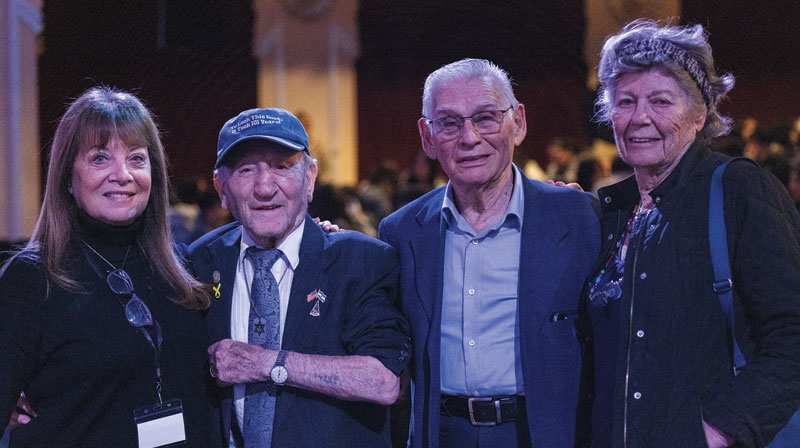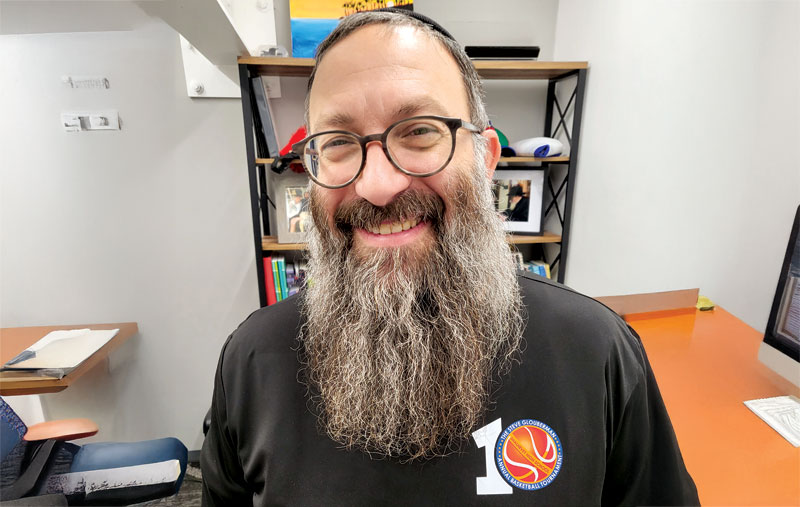In April 1982, Steve “Lips” Kudlow, front man of the heavy metal band Anvil, appeared on the cover of a British music tabloid wearing studded leather and wielding a chainsaw with a dildo between his teeth.
The image (and the accompanying story) stunned a British teenager, Sacha Gervasi, who attended Anvil’s concert at London’s legendary Marquee club and was “riveted by this lunatic front man jumping about in a bondage harness, playing slide guitar with a marital aide.” Over the next few years, Gervasi worked as a roadie for the band, which Kudlow and his best friend, drummer Robb Reiner, had founded while growing up in a Jewish neighborhood in Toronto.
Two decades later, Gervasi revisited the bandmates to shoot the documentary “Anvil! The Story of Anvil,” which has been selected as the centerpiece film among some 230 features, shorts and music videos to screen at the Los Angeles Film Festival, June 19-29. The movie describes the years the band inspired future metal royalty, such as Metallica and Slayer, whose members appear on camera; it recounts Anvil’s descent into obscurity in the mid-1980s and the founders’ struggle to keep rocking, even while holding down day jobs, into middle age.
Along the way, Kudlow and Reiner embark upon a grossly mismanaged Eastern European tour (a fight breaks out when one club manager attempts to pay them in goulash), they reunite with a top metal producer for their 13th album and finally perform a triumphant “return” concert in Japan.
Critics have lauded the documentary as “a real-life ‘This is Spinal Tap,'” (although drummer Reiner is not to be confused with that mockumentary’s director, Rob Reiner). A Rolling Stone headline asked whether “Anvil!” is the year’s “great rock movie,” and Variety called it “an underdog saga even nonmetalheads will root for.”
“On one level, the film is about these funny metal guys playing music into their 50s, but on another, it’s about best friends with a vision they’ve never given up,” Gervasi said.
Kudlow and Reiner — who alternatively appear close or at one another’s throats — are a study in opposites. The likeable but high-strung Kudlow is the son of a Polish immigrant tailor who frowned on his rock ‘n’ roll fantasies. Kudlow told The Journal he went through with his bar mitzvah just so he could buy a guitar with the gift money, but his dad barred him from playing music at home. The taciturn Reiner, meanwhile, is the son of a Hungarian-born Auschwitz survivor — a jeweler who not only encouraged his son’s music, but paid $25,000 to finance Anvil’s first album.
Sascha Gervasi, the director of “Anvil! The story of Anvil” joins Jian Ghomeshi in Studio Q
“My dad saw his own father die three days before the camp was liberated,” Reiner said from his Toronto home. “After what he had been through, he only wanted to see his children happy.”
Kudlow introduced himself to Robb after hearing drum riffs blasting from Reiner’s home, and the teenagers began rehearsing daily in Robb’s basement. “Steve dropped out of school as soon as he met Robb,” Kudlow’s mother complains in the film.
Gervasi angered his own parents — especially his father, an Oxford economics professor — by declining a history fellowship to Harvard University to pursue a career as a heavy metal drummer. Eventually he gave that up to attend King’s College in London, UCLA’s film school and to pursue a career in screenwriting, penning 2004’s “The Terminal” for Steven Spielberg and Tom Hanks in 2000.
The following year, Gervasi was surfing the net late at night when he suddenly wondered what had happened to his friends from Anvil. “I assumed that they had either broken up or killed each other,” he said. Instead, he discovered through the band’s Web site that “Anvil had released nine more albums since I had last spoken to them, and I hadn’t ever heard of a single one.” He promptly e-mailed Kudlow, who flew out to Los Angeles for a social visit.
The idea for the film hit Gervasi during that visit — specifically, on the day he took Kudlow to meet his mentor, Steven Zaillian, the screenwriter of “Schindler’s List.”
“Lips [Kudlow] was talking in a very animated way about his latest album or tour, and I told Steven, ‘He never gave up, and his passion is exactly as I remember from when I was a kid. He still believes Anvil can make it.’ I found that remarkable and said, ‘There might be a film here.'”
Gervasi mortgaged his home to shoot 320 hours of film from 2005 to 2007 — much of it following Anvil’s miserable Eastern European tour. On that trip, the frustrated Kudlow sometimes vented his anger at Reiner, who quit the band several times in response.
Yet they stayed best friends: “I think that Robb and Lips are both outsiders in a way,” Gervasi said of their camaraderie. “Steve has always been the black sheep of his family; his siblings include a doctor and an accountant. And Robb, I think, was quite damaged by his father’s Holocaust experience, even though [the elder Reiner] was supportive and rarely talked about the camps.”
Their interactions at times are so reminiscent of “Spinal Tap” that Gervasi’s cinematographer pulled him aside — during the goulash incident — to ask whether the bandmates were actually actors. “Once Lips ran offstage and was kneeling in pain with his hands down his trousers,” Gervasi said. “He’d sung so hard that his hemorrhoids had popped out. Then he ran back onstage and sang a song.”
“We decided not to put that incident in the film — although I must say it’s one of the funniest things I’ve ever seen — because we didn’t want to ridicule these middle-aged guys who were still trying to rock like 20-year-olds,” he added.
“Through everything, they continued following their dream. And that’s what makes their story so compelling.”
“Anvil” will screen June 26 at the John Anson Ford Amphitheatre, after which the band will perform in person.






















 More news and opinions than at a Shabbat dinner, right in your inbox.
More news and opinions than at a Shabbat dinner, right in your inbox.